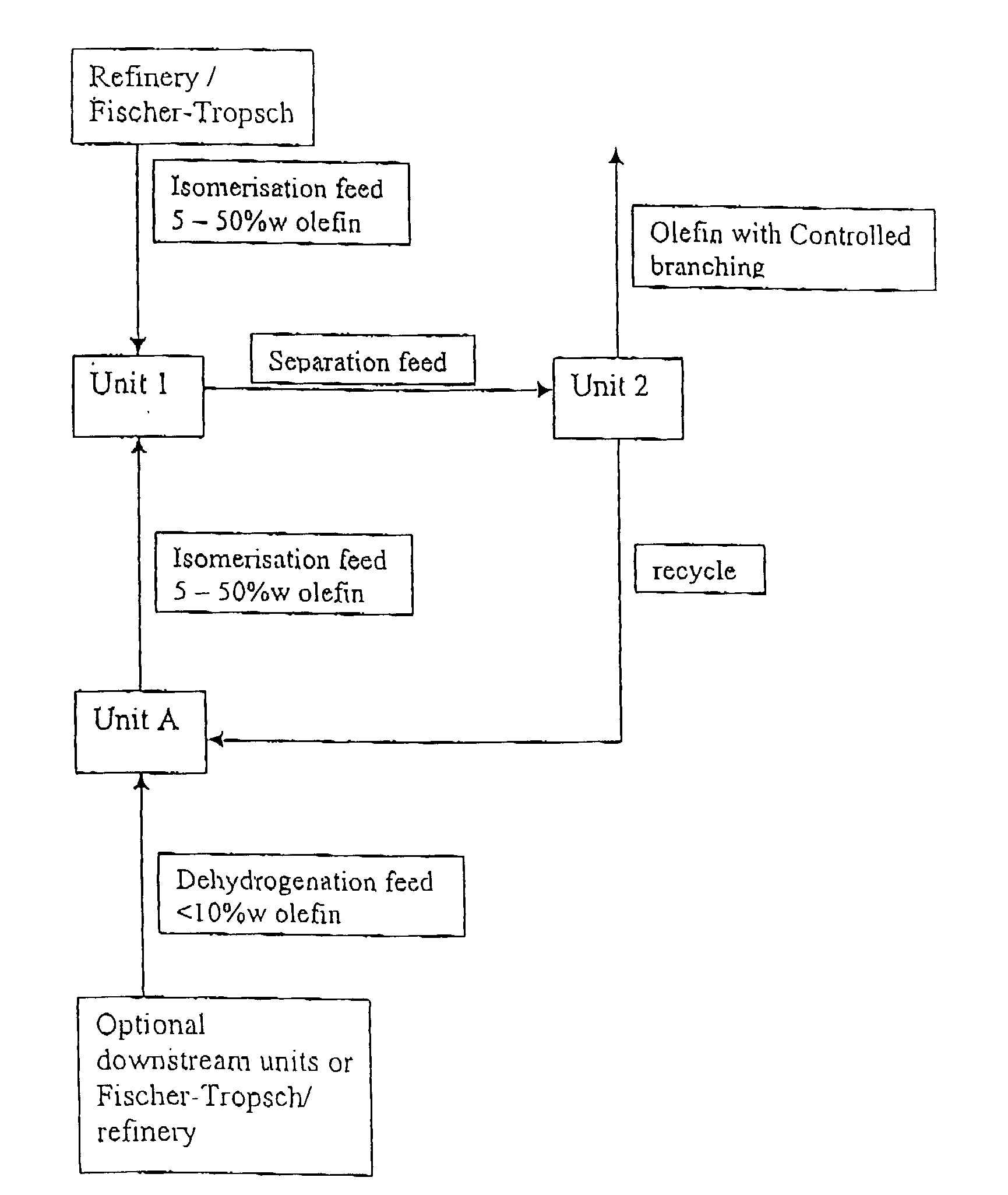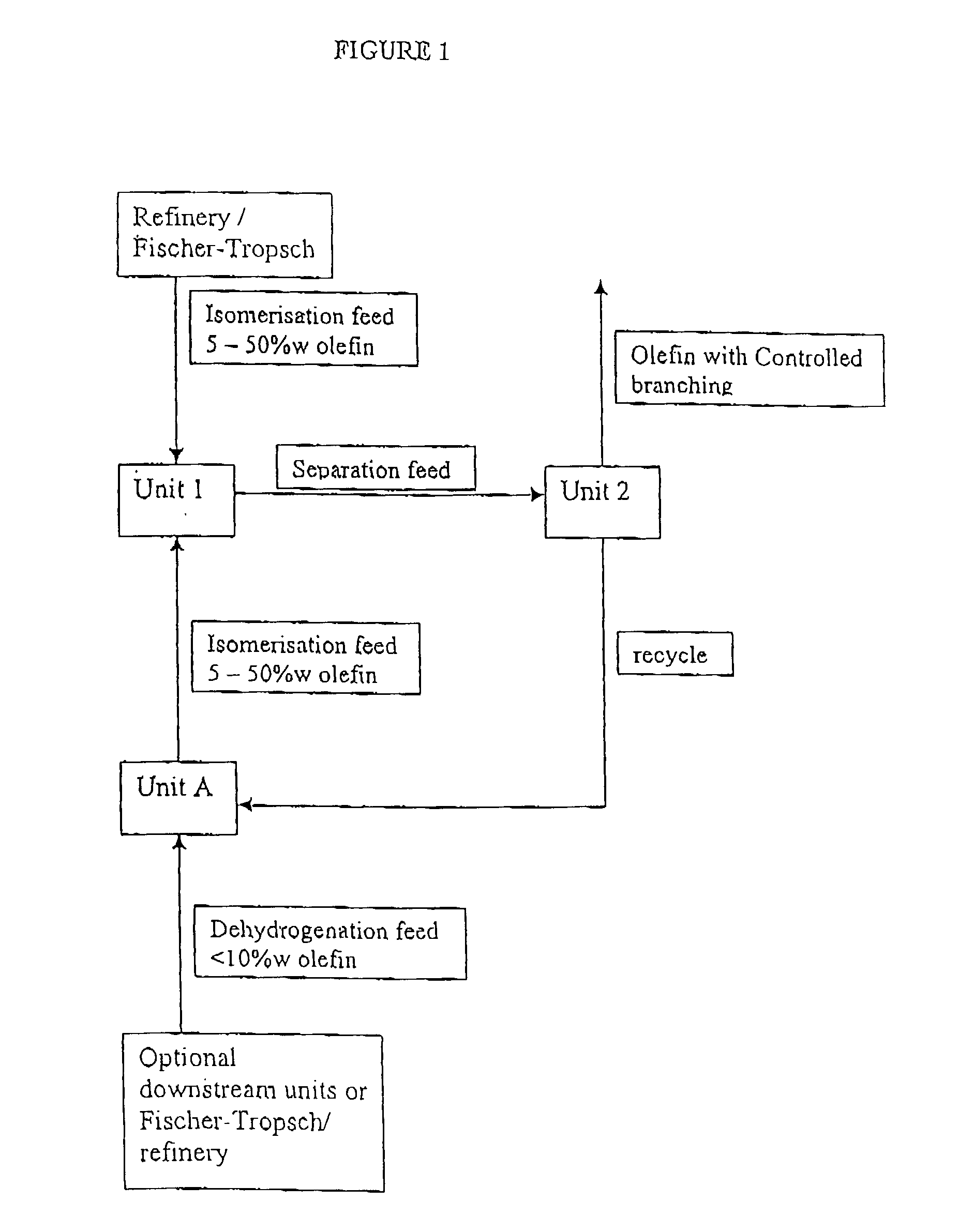Process for producing branched olefins from linear olefin/paraffin feed
a technology of branched olefins and paraffin feed, which is applied in the direction of liquid-gas reaction processes, chemical apparatuses and processes, organic chemistry, etc., can solve the problem of not being able to provide surfactants, and achieve the effect of reducing the size of the channel, and excellent selectivity
- Summary
- Abstract
- Description
- Claims
- Application Information
AI Technical Summary
Benefits of technology
Problems solved by technology
Method used
Image
Examples
examples
[0047]Illustrative examples of typical feed and product streams from processes using the apparatus of FIG. 1 are described in Examples 1 to 3 below and are given in the following Tables 1 to 4.
example
Example 1
Fresh Feed to Isomerisation Unit
[0048]In this example fresh feed is passed to isomerisation Unit 1 only (To U1); product stream is passed to Unit 2 for linear / branched separation (U1 / U2); olefin product is obtained from Unit 2 (From U2); unconverted (linear paraffin and any remaining linear olefin) feed is recycled from Unit 2 to dehydrogenation Unit A (U2 / UA); and the resultant linear olefins from Unit A are passed back to Unit 1 for isomerisation (UA / U1).
[0049]The olefin product from the Example is shown in column 5 (From U2) and represents 100% conversion to branched olefin.
[0050]
TABLE 1Model Mass Balance using arbitrary flow units,for case with fresh feed to Unit 1FromTo U1To UAU1 / U2U2U2 / UAUA / U1Linear olefin3001101181Branched olefin0010010000Linear paraffin7008000800730
example 2
Fresh Feed to Dehydrogenation Unit
[0051]In this example fresh feed is passed to dehydrogenation Unit A only (To UA); product of dehydrogenation Unit A is passed to Unit 1 (UA / U1); product stream of Unit 1 is passed to Unit 2 for linear / branched separation (U1 / U2); olefin product is obtained from Unit 2 (From U2); unconverted (linear paraffin and any remaining linear olefin) feed is recycled from Unit 2 to dehydrogenation Unit A (U2 / UA); and the resultant linear olefins from Unit A are passed back to Unit 1 for isomerisation (UA / U1).
[0052]The olefin product from the Example is shown in column 5 (From U2) and represents 100% conversion to branched olefin.
[0053]
TABLE 2Model Mass Balance using arbitrary flow units,for case with fresh feed to Unit ATo U1To UAU1 / U2From U2U2 / UAUA / U1Linear olefin0011011111Branched0010010000olefinLinear01001000010001000paraffin
PUM
| Property | Measurement | Unit |
|---|---|---|
| weight % | aaaaa | aaaaa |
| diameter | aaaaa | aaaaa |
| diameter | aaaaa | aaaaa |
Abstract
Description
Claims
Application Information
 Login to View More
Login to View More - R&D
- Intellectual Property
- Life Sciences
- Materials
- Tech Scout
- Unparalleled Data Quality
- Higher Quality Content
- 60% Fewer Hallucinations
Browse by: Latest US Patents, China's latest patents, Technical Efficacy Thesaurus, Application Domain, Technology Topic, Popular Technical Reports.
© 2025 PatSnap. All rights reserved.Legal|Privacy policy|Modern Slavery Act Transparency Statement|Sitemap|About US| Contact US: help@patsnap.com


